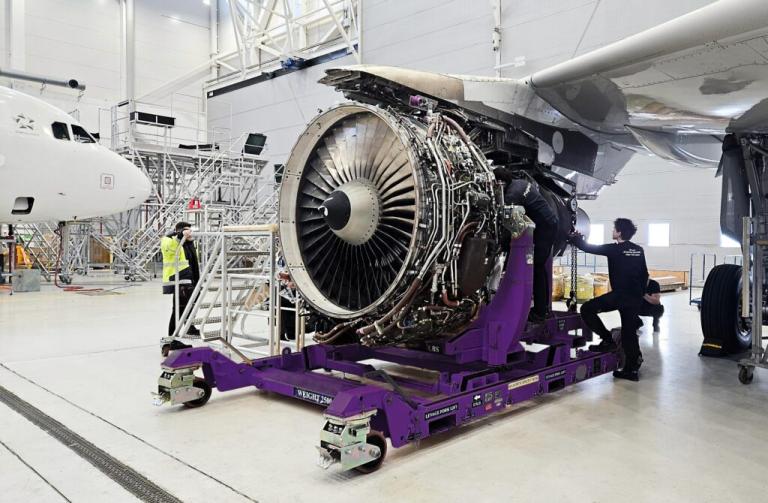How Do You Move a Jet Engine the Size of a Small House?
Magnetic Enginestands we eliminate the uncertainty from engine transportation. You get the right stand for the exact engine model, straightforward instructions, the passport-style documents
Short answer: with a purpose-built “seatbelt on wheels” called an engine stand. Longer answer – it’s a careful mix of smart design, gentle handling, and tidy paperwork that turns many tons of precision hardware into a safe, shippable package.
Really long answer…..
From a distance, a jet engine looks like a tough metal drum. Up close, it’s more like a luxury watch – thousands of finely balanced parts that dislike bumps, dust, and moisture.
When an engine is removed from the wing for maintenance, you can’t put it on a pallet and call it a day. You place it in an engine stand – a certified cradle with wheels – so it’s supported in the specific structural points, protected from the elements, and easy to move by truck, plane, or ship.
What Exactly Is an Engine Stand?
Think of a child’s car seat, scaled up for a very expensive grown-up. The stand is shaped to hug the engine at its strongest points, locks it in place so nothing shifts, and sits on a sturdy base you can lift and tie down safely.
The stand doesn’t just carry weight – it ensures the engine balance, low to the ground, and calm through corners, braking, and loading ramps.

Why Precision Fit Matter
Engines may look similar at first glance, but their shapes, connection points, and balance differ drastically – not to mention the sheer size and weight differences.
A stand made for one model won’t fit another, just like a stroller for a toddler won’t hold a newborn properly. A near-fit can cause pressure in the wrong place or let the engine nudge and wiggle in transit. Best case – the maintenance shop refuses delivery, and you lose days. Worst case – something bends inside that shouldn’t.
To put it into perspective, a typical CFM56 engine fitted to an Airbus A320 weighs between 2500-3000kg – while a Rolls-Royce Trent 1000 fitted to a Boeing 787 weighs around 6000kg.
A few millimeters of misalignment on equipment of this scale can make all the difference.
From Wing to Road Without Drama
Here’s the simple choreography. After the engine cools, technicians disconnect it and cover sensitive openings so dust and moisture stay out. The stand is rolled underneath like a parking spot that lines up perfectly.
Using hoists, the engine lowers into the cradle until it clicks into “its” position and is pinned securely – that’s the moment the stand takes the load.
Covers and protective caps go on, a few photos are taken to record the condition, and the accompanying documents are prepared. From there, the stand’s built-in lift points and tie-downs make loading predictable for drivers and loaders.
At the other end, the receiving team follows the same steps in reverse, checking seals and taking photos so everyone agrees the engine arrived exactly as sent.
Paperwork – the Engine’s Passport
Transporting a jet engine isn’t only about metal and wheels – it’s also about trust. Shippers and insurers want proof that the load is properly secured. Maintenance shops want to know exactly what they’re receiving.
That’s why each move travels with a “passport”: a certificate for the stand, a packing list that matches every cover and bracket, and a short condition report with photos and seal numbers. Clear documents mean fewer questions, quicker customs, and faster shop starts.
Rain, Snow, and Bumps: Keeping the Engine Comfortable
Engines don’t like moisture any more than laptops do. Stands pair with snug covers and, for longer trips, moisture-absorbing packs inside the covers to keep the internals dry.
The base keeps the center of gravity low, so the load behaves well on the road – no surprise tipping when a truck brakes or turns. In short, comfort on the move equals health in the shop.
“But Isn’t It Just a Big Metal Frame?”
Not really. Stands are designed and certified for specific engines. The shapes, locks, and lifting points are drawn to exact standards, the same way a seatbelt anchor in a car must be in the right place and strong enough to trust. That precision is what lets a crew move something bus-heavy with confidence.
Magnetic Enginestands we eliminate the uncertainty from engine transportation. You get the right stand for the exact engine model, straightforward instructions, the passport-style documents - and we also coordinate directly with your logistics partner or manage shipping on your behalf, ensuring the entire process remains transparent, compliant and efficient.
Pickup and delivery use a short, photo-friendly checklist so both sides have proof of condition.
The goal is simple – less friction, more on-time arrivals.
One Thing To Remember…
An engine stand is the safe seat for a very valuable passenger – it protects the engine, satisfies the paperwork, and keeps schedules intact. Choose the stand made for your engine, lock it in, keep it dry, and send the passport with it. When every detail is managed, moving “a small house” becomes a routine Tuesday.
readd more:-https://www.magneticgroup.co/how-do-you-move-a-jet-engine-the-size-of-a-small-house/